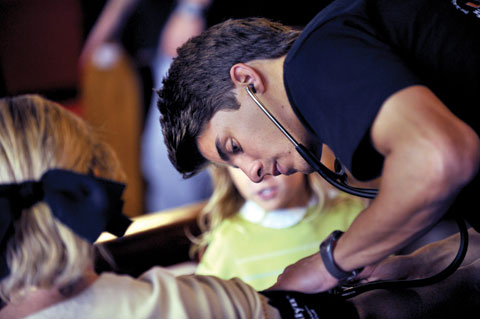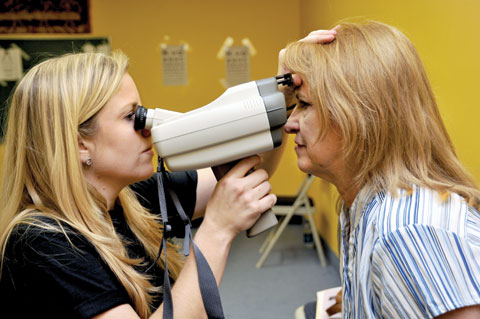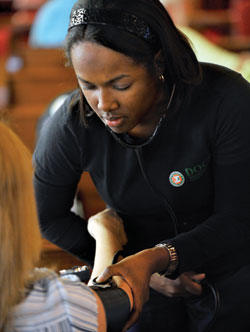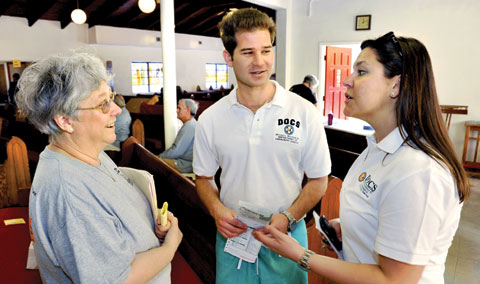 |
 |
Life-Transforming Fairs
By Dwayne Campbell | Photos by Rob O'Neal
One of the highlights of students’ medical education, the DOCS (Department of Community Service) health fairs furnish vital health screenings and education to thousands of underserved South Florida residents.
 |
| Christopher Goiney, a first-year medical student, measures a patient’s blood pressure at the Big Pine Key DOCS health fair. |
“If it weren’t for these students, I don’t know how long it would have taken me to find out. If they hadn’t found the spot, I wouldn’t have gone to the doctor to have it checked out,” says Linda Tatum, a faithful of the health fairs run by the medical students at the Miller School of Medicine.
It turned out the spot was cancerous.
“They might have saved my life.”
On a Saturday morning, far from the Miller School campus in Miami, medical students are up early. The energy is palpable as they grab cups of coffee and make last-minute checks before leaving their hotel and fanning out for the three simultaneous, student-run health fairs they will staff for six hours—or until the last patient is served. The students, from the medical school’s Mitchell Wolfson Sr. Department of Community Service (DOCS) program, don’t know what they will encounter—but over a long time they have seen much, including people with dangerously high blood pressure, precancerous lesions, and even those who were first-line candidates for cardiac arrest.
By the end of the day, more than 700 men, women, and children, most of them uninsured, would be put through a battery of health screenings at the Florida Keys health fairs, including the one on Big Pine Key at the Methodist and Baptist churches, houses of worship that stand side by side on Key Deer Boulevard and are transformed each year into virtual hospitals. That’s where Tatum, a veteran of the UM health fairs since the very first one was held on Big Pine in 1971, shows up. She has never missed one.
“A lot of us in Monroe County don’t have health insurance, so we make sure to take advantage of all the services they offer,” Tatum says. “And, moreover, the students are wonderful; they treat you with the kind of compassion you hope everyone gets when they seek medical care.”
Nancy Heater, a Key West nurse and 20-year fair volunteer, knows the stories well.
“One year they discovered that a pastor at one of the churches had a thyroid condition he didn’t know about,” says Heater. “He was very grateful. Some people find out they need to be treated for certain conditions, and this is where they hear it first. Many people have gone to the doctor because of what they found out here. This health fair has a great reputation. Some of our patients go way back, and new ones discover it every year.”
New patients this year included Greta Bennett, who saw the health fair mentioned in a local newspaper.
“The service is excellent,” says Bennett. “You know they are students, but they are very professional. In this economy they are offering so much for so little. I’m definitely coming back next year.”
It’s the long-timers like Linda, the newcomers like Greta, and the thousands between who have inspired UM medical students to volunteer for DOCS for so many years.
 |
| Erin Forster, left, a second-year medical student, gives Linda Tatum an eye exam. |
“We have a tradition of success that comes from the strong foundation built on the willingness of the students, faculty, and volunteers who simply come together throughout the year to help others,” says Oren Goltzer, a cheerful second-year student who is this year’s site director for the Big Pine Key health fair—the birthplace and holy grail of Miller School health fairs. “The fact that so many people have been coming back for so long says a lot about what we do. I see it as a sign of confidence.”
Compassionate care has been offered in Big Pine Key every year since Iris M. Kiem, Ph.D., a faculty member in the Department of Epidemiology and Public Health who owned a home there, asked a handful of medical students to volunteer for a day administering health screenings to residents. Kiem, who retired in 1988, says the fairs drew large crowds in the 1970s because there were few doctors in the Keys, and the need for local preventive care was mostly unmet.
In those days, the fair survived on small fundraising efforts and donations
of medical supplies from local drug stores. Students would spend the night in the homes of the local volunteers. Promotion was through churches and word of mouth.
But what began in Big Pine as a loosely organized effort has grown into a volunteer medical phenomenon that has touched thousands of lives in South Florida. Encouraged by the success, students took on separate foreign missions, delivering free medical services and the UM name to other parts of the world.
Today, in addition to Big Pine Key, the Mitchell Wolfson Sr. Department of Community Service health fairs are held annually in Pompano Beach in Broward County; in Hialeah, Little Haiti, and Homestead in Miami-Dade County; and in three additional Florida Keys locales: Tavernier, Key West, and Marathon. On Tuesday evenings, patients are seen free of charge at San Juan Bosco Clinic at Corpus Christi Church in Miami’s Little Havana neighborhood. Most recently, DOCS reached out to provide weekly medical care to patients at Lotus House, a shelter for homeless women in Miami.
In 2006 the organization incorporated the Wolfson name after the Wolfson Foundation recognized the students’ longstanding and outstanding work with a $75,000 annual grant for three years. In 2007 DOCS won a Health Care Heroes Award from the Greater Miami Chamber of Commerce.
 |
| A health fair patient gets her blood pressure measured by first-year medical student Ronine Zamor. |
The DOCS action plan was in effect on January 24, the day of the Florida Keys health fairs, when Josefina Farra, a fourth-year medical student and this year’s DOCS executive director, marshaled a team of 250 students and 60 physicians, medical residents, and local volunteers. It is part of her role as overseer to make sure that everything, medically and logistically, operates at peak efficiency. Each site in the Keys and elsewhere is directly run by one of her deputies, a total effort that now allows DOCS to see about 2,000 patients annually—and tens of thousands since the original program began.
“The DOCS staff works tirelessly to ensure that every patient receives the care they deserve,” says Farra. “Students spend hours each week in the DOCS office planning the fairs—dealing with logistical issues, organizing lab results, arranging referral clinics for follow-up, training students, recruiting physician and student volunteers, and doing research.
“All in all, we spend a great deal of time helping to make DOCS successful. But year after year we come to the same conclusion. Every health fair, every clinic, every patient is worth it.”
In the years following the Big
Pine Key health fair and prior to the establishment of DOCS, a multitude of new student groups started their own health fairs and also began serving at clinics, recalls Mark T. O’Connell, M.D., who had assisted at several of the fairs. When he became senior associate dean for medical education in 1999, O’Connell suggested that the groups consolidate budgets; create standards for services they provide; ensure that students were fully trained in their volunteer duties; and standardize paperwork, charting, and supplies. The various groups came together under the DOCS umbrella in 2000.
“It’s gratifying to see where they are today,” says O’Connell. “If you look at the number of patients served, the kinds of problems detected, the follow-up and commitment year after year, it’s incredibly impressive.”
Patients, of course, are the true beneficiaries of a more organized and better-funded DOCS.
“We don’t have to go looking
for Band-Aids like in the very old
days; everything is brought down
from Miami,” says longtime volunteer Heater. “What they do now is amazing—the preparation, the public relations. The students are well trained, and they keep adding services to respond to community needs.”
Big Pine Key residents still trek to the Methodist church where it all began and to the Baptist church to which it expanded. Visit the churches at the once-a-year health fair and you’ll see people in pews waiting to get their blood pressure checked, women in the church’s playroom waiting for female exams, and men lining up outside an office turned into a prostate exam center. In all, medical students and their doctor mentors staff more than a dozen medical stations and screen for hypertension, diabetes, obesity, dyslipidemia, vision loss, and depression, as well as for skin, prostate, colon, breast and cervical cancer. Through partnerships with health care organizations, several booths provide information on alcohol use, domestic violence, immunizations, HIV/AIDS, and smoking cessation. Through Project Prevent, an initiative that provides cervical cancer education, women are screened and vaccinated against HPV.
 |
| Nancy Heater, left, a nurse and coordinator of the Big Pine Key Health Fair community volunteers, discusses the fair with site director Oren Goltzer, a second-year medical student, and DOCS executive director Josefina Farra, a fourth-year student. |
For many Miller students, participating in DOCS is as much a part of the medical school experience as learning anatomy. In addition to providing much-needed health care to underserved populations, a goal of the organization is to provide hands-on education.
“For first- and second-year students it’s a welcome change of pace from constant studying, and it allows them to place the medical science they learn into the context of real patients,” says fourth-year student O’Rese Knight, who has volunteered at the vision station at several fairs in each of his four years at medical school. “But the best part is hearing patients’ testimonies that their glaucoma was discovered at one of our health fairs. Seeing them perform well on our screening exams ten, sometimes 20 years later, always makes my day.”
Even former students who are now doctors return to help. Nathan Connell, M.D., a 2007 Miller School graduate and former DOCS executive director, took a vacation from his Brown University residency to lend a hand in the Keys. “This is where I learned many of the skills I use as a resident,” says Connell. “I learned how to counsel primary care, how to counsel about blood pressure and glucose and cholesterol. I learned it all right here as a second-year student sitting next to one of our residents or faculty members.”
Chris Caulfield, M.D., DOCS executive director after Connell and now a resident at University of North Carolina at Chapel Hill, says DOCS provides students with a “unique system of teaching and learning that shapes the way I treat patients today.”
Upwards of 90 percent of students who graduate from the Miller School have participated in at least one DOCS health fair.
“Community service is an integral part of studying medicine at the Miller School, and DOCS upholds that tradition with the highest medical competency and compassion,” says Dean Pascal J. Goldschmidt, M.D., who joins the faculty volunteers at some of the health fairs. “Students we recruit are anxious to join DOCS, our faculty is extremely supportive of it, and the patients who benefit keep reminding us that we are making a great contribution to the health of South Florida.”
Back at Big Pine Key, Linda Tatum, armed with her thick medical file, is waiting at the check-out center, a bustling hall in the Baptist church where about a dozen other patients who are finished with their screenings are getting final words from doctors and medical students.
Tatum wears an expression of contentment. According to the screenings, she has nothing to worry about.
“There are people here who can’t afford to go anywhere else,” Tatum says. “We would really miss them if they weren’t here.” |
 |
 |


